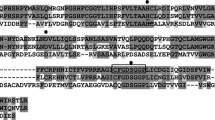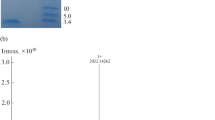Abstract
The proteolytic fragments of native fibronectin (cryopeptides) complexed to pathological immunoglobulins in cryoglobulins were isolated from the serum of six different patients. Two peptides of 117,000 daltons and 70,000 daltons were purified and characterized byN-termmal amino acid sequencing. The priming effect of the mixture of these two peptides, referred to as cryopeptides, on neutrophil functions, namely the respiratory burst, exocytosis, and Ca2+ release, was investigated. Cryopeptides and cryoglobulins assayed separately did not increase neutrophil respiration or cytosol free calcium concentration; however, both of them induced granule enzyme secretion. Sequential exposure of neutrophils to either cryopeptides or the respective cryoglobulins, and then toN-formyl-methionyl-leucyl-phenylalanine or serum opsonized zymosan, resulted in a synergistic stimulation of O2 uptake compared to the effect ofN-formyl-peptides or opsonized zymosan tested separately; Ca2+ release was significantly enhanced by the pretreatment of neutrophils with cryopeptides. These data suggest that cryopeptides and cryoglobulins may play a role in host defense against bacterial infections through neutrophil activation.
Similar content being viewed by others
References
Cordonnier, D. J., J. C. Renversez, P. Vialtel, andE. Dechelette. 1987. The kidney in mixed cryoglobulinemias.Springer Semin. Immunopathol. 9:395–415.
Renversez, J. C., C. Revol, andM. J. Valle. 1986. Fibronectin fragments act as promoters of immunoglobulin cryoprecipitation.In Marker Proteins in Inflammation. J. Bienvenu, A. Grimaud and Ph. Laurent, editors. Walter de Gruyter, Berlin. 195–199.
Rostagno, A. A., B. Frangione, andL. I. Gold. 1989. Biochemical characterization of the fibronectin binding sites for IgG.J. Immunol. 143:3277–3282.
Renversez, J. C., C. Revol, andM. J. Valle. 1985. Immunogold staining of blotted proteins-demonstration that fibronectin initiates the immunoglobulin cryoprecipitation.In Protides of the Biological Fluids. H. Peeters, editor. Pergamon Press, New York. 601–604.
Vartio, T., andA. Vaheri. 1983. Fibronectin: Chains of domains with diversified functions.TIBS 8:442–444.
Garcia-Pardo, A., A. Rostagno, andB. Frangione. 1987. Primary structure of human plasma fibronectin.Biochem. J. 241:923–928.
Hynes, R. 1985. Molecular biology of fibronectin.Annu. Rev. Cell. Biol. 1:67–90.
Roos, D., A. A. M. Bot, M. L. S. Vanschaik, M. De Boer, andM. R. Daha. 1981. Interaction between human neutrophils and zymosan particles: The role of opsonins and divalent cations.J. Immunol. 126:433–440.
Dewald, B., J. Doussiere, F. Morel, M. Baggiolini, andP. V. Vignais. 1988. Neutrophils. Respiratory burst and exocytosis.In Dynamics of Membrane Proteins and Cellular Energetics. N. Latruffe, Y. Gaudemer, P. Vignais and A. Azzi, editors. Springer-Verlag, Berlin. 134–153.
Morel, F., andP. V. Vignais. 1984. Examination of the oxidase function of the b-type cytochrome in human polymorphonuclear leucocytes.Biochim. Biophys. Acta 764:213–225.
Wymann, M. P., V. Von Tscharner, D. A. Deranleau, andM. Baggiolini. 1987. Chemiluminescence detection of H2O2 produced by human neutrophils during the respiratory burst.Anal. Biochem. 165:371–378.
Treves, S., D. Milani, andT. Pozzan. 1988. Intracellular Ca2+ measurements in intact neutrophils.In Dynamics of Membrane Proteins and Cellular Energetics. N. Latruffe, Y. Gaudemer, P. Vignais, and A. Azzi, editors. Springer-Verlag, Berlin. 222–230.
Dewald, B., andM. Baggiolini. 1986. Methods for assessing exocytosis by neutrophil leukocytes.Methods Enzymol. 132:267–277.
Bradford, M. M. 1976. A rapid and sensitive method for the quantitation of microgram quantities of protein utilizing the principle of protein-dye binding.Anal. Biochem. 72:248–254.
Renversez, J. C., S. Roussel, M. J. Vallee, G. Brighouse, andP. H. Lambert. 1984. Idiotypic interactions in type II mixed cryoglobulins.In Antiglobulins, Cryoglobulins and Glomerulonephritis. C. Ponticelli, editor. Martinus Nijhoff, Dordrecht, The Netherlands. 147–160.
Mancini, C., A. O. Carbonara, andJ. H. Heremans. 1965. Immunochemical quantitation of antigens by radial immunodiffusion.Immunochemistry 2:235–254.
Laemmli, U. K. 1970. Cleavage of structural proteins during the assembly of the head of bacteriophage In.Nature 227:680–685.
Kuroiwa, A., K. Igisu, T. Yano, N. Okada, andH. Okada. 1988. Fibronectin enhances respiratory burst of phagocytes stimulated by zymosan and immune complexes.Immunology 65:177–180.
Proctor, R. A. 1987. Fibronectin: An enhancer of phagocyte function.Rev. Infect. Dis. 9:S412-S419.
Marino, J. A., andP. J. Spagnuolo. 1988. Fibronectin and phagocytic clearance mechanisms.J. Lab. Clin. Med. 111:493–494.
Forsyth, K. D., andR. J. Levinsky. 1990. Fibronectin degradation; an in-vitro model of neutrophil mediated endothelial cell damage.J. Pathol. 161:313–319.
Lambert Vidmar, S., F. Lottspeich, I. Emod, T. Planchenault, andV. Keil-Dlouha. 1991. Latent fibronectin-degrading serine proteinase activity in N-terminal heparin-binding domain of human plasma fibronectin.Eur. J. Biochem. 201:71–77.
Lambert Vidmar, S., F. Lottspeich, I. Emod, J. M. Imhoff, andV. Keil-Dlouha. 1991. Collagen-binding domain of human plasma fibronectin contains a latent type-IV collagenase.Eur. J. Biochem. 201:79–84.
Pommier, C. G., S. Inada, L. F. Fries, T. Takahashi, M. M. Frank, andE. J. Brown. 1983. Plasma fibronectin enhances phagocytosis of opsonized particles by human peripheral blood monocytes.J. Exp. Med. 157:1844–1854.
Yang, K. D., N. H. Augustine, L. A. Gonzales, J. F. Bohnsack, andH. R. Hill. 1988. Effects of fibronectin on the interaction of polymorphonuclear leukocytes with unopsonized and antibody-opsonized bacteria.J. Infect. Dis. 158:823–830.
Rourke, F. J., F. A. Blumestock, andJ. E. Kaplan. 1984. Effect of fibronectin fragments on macrophage phagocytosis of gelatinized particles.J. Immunol. 132:1931–1936.
Wikner, N. E., andR. A. F. Clark. 1988. Chemotactic fragments of fibronectin.Methods Enzymol. 162:214–222.
Stanislawski, L., T. Pham Huu, andA. Perianin. 1990. Priming effect of fibronectin on respiratory burst of human neutrophils induced by formyl peptides and platelet activating factor.Inflammation 14:523–530.
Ehrlich, M. L., J. S. Krushell, F. A. Blumenstock, andJ. E. Kaplan. 1981. Depression of phagocytosis by plasmin degradation products of plasma fibronectin.J. Lab. Clin. Med. 98:263–271.
Norris, D. A., R. A. F. Clark, L. M. Swigart, J. Clark Huff, W. L. Weston, andS. E. Howell. 1982. Fibronectin fragment(s) are chemotactic for human peripheral blood monocytes.J. Immunol. 129:1612–1618.
Lohr, K. M., C. A. Kurth, D. L. Xie, J. M. Seyer, andG. A. Homandberg. 1990. Theammo-terminal 29- and 72-kD fragments of fibronectin mediate selective monocyte recruitment.Blood 10:2117–2124.
Doherty, D. E., P. M. Henson, andR. A. F. Clark. 1990. Fibronectin fragments containing the RODS cell-binding domain mediate monocyte migration into the rabbit lung.J. Clin. Invest. 86:1065–1075.
Haslett, C., J. S. Savill, andL. Meagher. 1989. The neutrophil.Curr. Opin. Immun. 2:10–18.
Tauber A. I. M. D.,A. B. Karnad, M.D.,K. L. Hartshorn, M.D.,J. B. Myers, andJ. H. Schwartz M.D. 1989. Parameters of neutrophil activation models of priming and deactivation.In Biochemistry of the Acute Allergic Reactions: Fifth international symposium. Alan R. Liss, New York. 297–309.
Kazura, J. W., J. D. Wenger, R. A. Salata, A. Z. Budzynski, andG. H. Goldsmith. 1989. Modulation of polymorphonuclear leukocyte microbicidal activity and oxidative metabolism by fibrinogen degradation products D and E.J. Clin. Invest. 83:1916–1924.
Wachtfogel, Y. T., W. Abrams, U. Kucich, G. Weinbaum, M. Schapira, andR. W. Colman. 1988. Fibronectin degradation products containing the cytoadhesive tetrapeptide stimulate human neutrophil degranulation.J. Clin. Invest. 81:1310–1316.
Author information
Authors and Affiliations
Rights and permissions
About this article
Cite this article
Morel, F., Cohen Tanugi Cholley, L., Dianoux, A.C. et al. Modulation of human neutrophil function by fibronectin degradation products isolated from cryoglobulins. Inflammation 16, 325–341 (1992). https://doi.org/10.1007/BF00917625
Issue Date:
DOI: https://doi.org/10.1007/BF00917625




